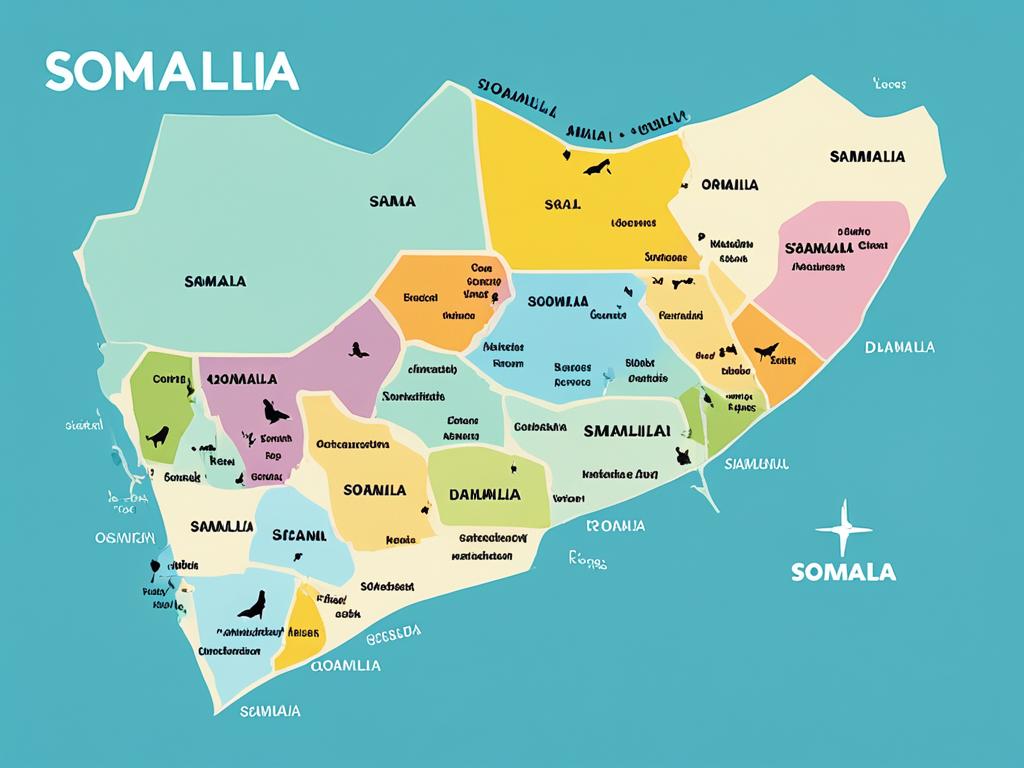Imagine a unique language as captivating as the Somali people themselves. The Somali language is an Afro-Asiatic tongue. It’s part of the Cushitic branch, spoken by ethnic Somalis in the Horn of Africa and globally. This language is a treasure trove filled with a rich history, cultures, and linguistic variety.
The world of Somali is distinct and fascinating. You’ll notice its long, speckled “fur” (its complex phonology). Also, its playful and affectionate nature shines through. The Somali language truly reflects the Somali people. It shows their resilience, creativity, and close ties to their heritage.
Are you a linguist, a Somali-speaker, or just curious about languages? The Somali language is a journey you’d love. Its diverse dialects, unique script, and rich literary traditions await you. You’ll discover a world that’s both known and yet new. It acts as a connection between past and present. Plus, it shows the lasting impact of language on our human story.
Key Takeaways
- The Somali language is an Afro-Asiatic language belonging to the Cushitic branch, spoken by ethnic Somalis in the Horn of Africa and the Somali diaspora.
- Somali is known for its unique linguistic features, including its intricate phonology, playful demeanor, and affectionate nature.
- The Somali language is a reflection of the Somali people’s rich history, cultural traditions, and linguistic diversity.
- Exploring the Somali language offers insights into the enduring power of language to shape and define human experience.
- The Somali language is a bridge between the past and the present, with a captivating literary tradition and diverse dialects.
Introduction to the Somali Language
Somali is an interesting language with roots in the Afro-Asiatic group, part of the Cushitic branch. It is spoken mainly in the Horn of Africa. This includes places like Somalia, Djibouti, Ethiopia, and Kenya. But Somali isn’t confined to this area; it’s also spoken by a large group of Somalis living all around the world.
Origins and Classification
Placed in the Afro-Asiatic group, Somali is related to languages like Arabic and Amharic. Being in the Cushitic subgroup shows its deep connections to the Horn of Africa. This region is famous for its many languages.
Geographical Distribution
Somali is mainly spoken in the Horn of Africa, particularly in Somalia. Other countries in the area, like Djibouti, Ethiopia, and Kenya, also use it due to their Somali populations. Yet, the language has traveled far through the Somali diaspora. This has made Somali a known language worldwide.
Linguistic Diversity
Somali showcases a fascinating range of dialects. Different versions of the language have developed over time. Each dialect has its own special words, sounds, and ways of using language. This shows the deep cultural connections of the Somali people and the language’s ability to change and grow.

Somali Dialects
The Somali language has many dialects, each unique. These dialects differ in vocabulary, pronunciation, and grammatical structure. This shows the wide cultural and geographic range of the Somali people. Knowing about these Somali dialects helps us communicate better and understand the Somali linguistic landscape.
There are three main Somali dialects: Northern, Central, and Southern. The Northern dialect has a unique accent and vocabulary. It’s spoken in northern Somalia. The Central dialect, used in central Somalia, is more standardized. The Southern dialect mixes Somali with Afro-Asiatic elements due to outside influence.
Within these big dialects, there are also sub-dialects. These are found in specific communities or areas. Each sub-dialect has its unique ways of using vocabulary, grammar, and idioms. This adds more color to the Somali linguistic diversity.

It’s very key to recognize and value the diversity in Somali dialects. This is good for talking well and for keeping the Somali people‘s culture and language alive. By digging into the details of these dialects, experts and fans of the Somali language can learn a lot. They can learn about its Afro-Asiatic and Cushitic origins. Plus, about how it has changed and had an impact in East Africa.
The Somali Script
The Somali script has a rich history with many writing systems over time. The Latin-based script became the standard in the 1970s. This change was a big step forward for Somali, making it more widely used in writing and speaking.
History of the Somali Script
Before the Latin script, Somalis used different ways to write their language. These included the Wadaad system, from Arabic, and the Osmanya system, created more recently. These old scripts helped keep Somali culture alive through writing, even as the language changed.
Alphabet and Orthography
The Somali alphabet has 22 letters, one for each sound in the language. This makes writing and reading Somali clear and systematic. Vowel sounds and special features in the language are shown with marks, keeping writing accurate.
Learning about Somali script helps in many ways, from understanding its history to better reading and writing. It’s key for anyone studying Somali or wanting to communicate with Somalis around the world.

Somali: Grammatical Structure
The Somali language has a complex grammar. It showcases unique aspects in nouns, verbs, and sentences. These features make Somali fascinating but challenging to learn.
Noun System
In Somali, nouns change for gender, number, and case. A word becomes definite by adding a suffix, like -ki or -ka for males and -ti or -ta for females. Plurals are made with many irregular suffixes or fixed endings.
Verb Conjugation
Somali verbs blend a base with different endings. Suffixes for verbs change by tense or mood, often at the end of words. Infinitives end with -i or -n, and verbal nouns have endings like -id or -n. There are four simple tenses and a subjunctive mood in Somali.
Sentence Structure
Sentences in Somali use an SOV order. Tonal marks show details like number or gender. This language uses special words like baa to make specific parts of sentences stand out.
Learning Somali‘s grammar is key to fully understanding and enjoying it. Books like “The Somali Language” and “Somali Reference Grammar” offer deep insight. They delve into the structure and nuances of the Somali language.
Somali Vocabulary
The Somali vocabulary shows many cultural and historical influences. Its core is from the Cushitic language family. Yet, Somali also uses words from Arabic, Italian, English, and more. This mixing happened because of trade, colonization, and globalization.
Loanwords and Foreign Influences
The Somali language has taken on words from other languages. This is especially true for Arabic, which has shaped Somali a lot. This is because of the close ties between the Horn of Africa and the Middle East. Words from Italian and English have also entered the Somali vocabulary. This was during the time of colonialism and after it ended.
Word Formation Processes
Besides using loanwords, the Somali language has its own way to create new words. It uses compounding and derivation. With compounding, words are joined to make a new one. With derivation, affixes are added to root words to form new ones. This kind of word-building keeps the Somali vocabulary fresh and growing, showing how the Somali language changes over time.
Somali Literature and Oral Traditions
Somali culture is known for its strong oral traditions. These traditions are key in keeping the history, customs, and values of the people alive over generations. Verbal art, like poetry and storytelling, is a significant way for the Somali people to express themselves and share knowledge.
Poetry and Storytelling
Somali poetry is full of beautiful sounds and pictures. It is a big part of what it means to be Somali. Poets, called gabayaa, are highly respected for how they talk about Somali life and dreams. They also share their thoughts on social and political matters. Poetic traditions are passed on orally. Poets often remember long poems and sometimes challenge each other with new verses.
Another vital part of Somali culture is storytelling. Somali folktales and legends entertain, teach, and share important values. These stories are often told by elders or gifted storytellers. They help form the Somali way of thinking and remember the past.
Modern Somali Literature
In the last several years, Somali writers and poets have begun a literary revival. They are blending old oral traditions with new ways of writing. These authors write about many topics, such as life in the diaspora, efforts to build their nation, and changes in Somali culture.
Their work includes novels, short stories, and poems. Through these, Somali writers are making the world notice Somali literature. They share the unique viewpoints and experiences of the Somali people.
The Importance of Somali Language
The Somali language is key to the Somali cultural identity. It unites the people and their diaspora. Somali is not just a way to talk. It shows their heritage, traditions, and values. This language comes from the Afro-Asiatic group, part of the Cushitic branch. It’s mostly used in the Horn of Africa, in places like Somalia, Djibouti, Ethiopia, and Kenya.
Cultural Identity
The Somali language is essential for the Somali people’s culture. It lets them share their history and customs. With many dialects, Somali is very diverse. This adds to the rich cultural fabric and strengthens the feeling of community. Keeping the Somali language alive is vital. It helps the Somali people keep their unique identity, at home and around the world.
Educational and Professional Opportunities
Supporting the Somali language creates chances in education and work for Somalis. Knowing Somali well gives an edge in many careers. Fields like linguistics, translation, and cultural studies look for Somali speakers. The language is gaining more respect worldwide. This means more jobs in diplomacy, academia, and more for Somali language experts.




